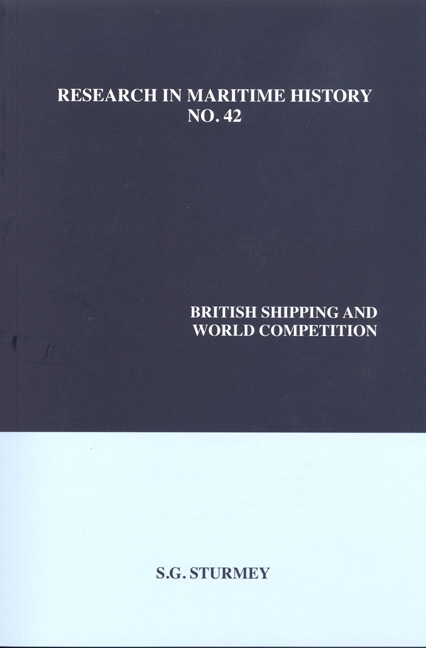Book contents
- Frontmatter
- Table of Contents
- Series Editor's Foreword
- About the Author
- Preface
- Figures and Tables
- Chapter 1 The Problem Defined
- Chapter 2 High Water: The Pre-1914 Period
- Chapter 3 War and Reconstruction
- Chapter 4 The Troubled Years: The Interwar Period
- Chapter 5 Nationalism in Shipping in the Interwar Years
- Chapter 6 The Birth of the Liberty
- Chapter 7 The Prosperous Age: The Postwar Period
- Chapter 8 Enemies of Competition in the Postwar Years
- Chapter 9 Flags of Convenience
- Chapter 10 Economics of Shipping Enterprises
- Chapter 11 Shipowning and Resource Allocation
- Chapter 12 Labour Relations and Labour Costs (by Basil Mogridge)
- Chapter 13 The Conference System
- Chapter 14 The Structure of the British Industry
- Chapter 15 The Question Answered
- Epilogue The Future
- Appendix The Contribution of British Shipping to the Balance of Payments
- Bibliography
- Index
Chapter 6 - The Birth of the Liberty
- Frontmatter
- Table of Contents
- Series Editor's Foreword
- About the Author
- Preface
- Figures and Tables
- Chapter 1 The Problem Defined
- Chapter 2 High Water: The Pre-1914 Period
- Chapter 3 War and Reconstruction
- Chapter 4 The Troubled Years: The Interwar Period
- Chapter 5 Nationalism in Shipping in the Interwar Years
- Chapter 6 The Birth of the Liberty
- Chapter 7 The Prosperous Age: The Postwar Period
- Chapter 8 Enemies of Competition in the Postwar Years
- Chapter 9 Flags of Convenience
- Chapter 10 Economics of Shipping Enterprises
- Chapter 11 Shipowning and Resource Allocation
- Chapter 12 Labour Relations and Labour Costs (by Basil Mogridge)
- Chapter 13 The Conference System
- Chapter 14 The Structure of the British Industry
- Chapter 15 The Question Answered
- Epilogue The Future
- Appendix The Contribution of British Shipping to the Balance of Payments
- Bibliography
- Index
Summary
This chapter covers the period from the outbreak of war to the completion of the transition from war to peace, taken here as the end of 1948.
War
The consideration will be restricted to two matters only, changes in tonnages during the war and the financial experiences of the war.
(a) Shipping Losses and New Building
During the war the losses of Commonwealth-owned ships amounted to 11.9 million tons. A further 9.8 million tons of Allied and neutral shipping was lost and approximately ten million tons of enemy shipping, making a total of about thirty-two million tons. This was just over one-half of the prewar fleet as shown in table 6.1. These losses must be considered alongside the building which occurred during the war. In 1946 the world fleet was estimated to be 72.9 million tons, an increase of 11.5 million tons over the 1939 total. This puts the total of new construction during the war at about forty-three million tons.
The building during the war was mainly of standard types of cargo vessels and tankers. There was rather more variety in the American building than in the British because the pressure in America was not so great or the shortage of materials so acute. The war-built American ships included the famous Liberty ships and tankers, in addition to fast cargo ships and transports suitable for use in peacetime liner trades and, in many cases, for conversion into passenger vessels.
Within the overall net increase of 11.5 million tons in the world merchant fleet between 1939 and 1946 there were considerable changes in the distribution between different countries. These changes may be summarized as follows:
The fleets of all of Britain's important rivals in the interwar period, except that of the United States, suffered heavier proportionate losses during the war than did the British fleet. The majority of those losses were directly due to the effects of war, although it is alleged that the decline in the Greek fleet was partly due to profitable sales. This allegation is not supported by the statistics of Greek ships chartered to the British government during the war.
- Type
- Chapter
- Information
- British Shipping and World Competition , pp. 117 - 134Publisher: Liverpool University PressPrint publication year: 2009



